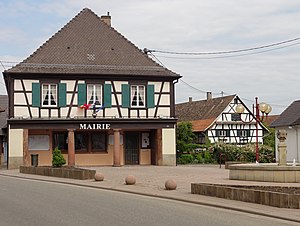Blaesheim
| Blaesheim | ||
|---|---|---|

|
|
|
| region | Grand Est | |
| Department | Bas-Rhin | |
| Arrondissement | Strasbourg | |
| Canton | Lingolsheim | |
| Community association | Eurométropole de Strasbourg | |
| Coordinates | 48 ° 30 ' N , 7 ° 37' E | |
| height | 146-198 m | |
| surface | 9.96 km 2 | |
| Residents | 1,316 (January 1, 2017) | |
| Population density | 132 inhabitants / km 2 | |
| Post Code | 67113 | |
| INSEE code | 67049 | |
| Website | www.blaesheim.fr | |
 Blaesheim City Hall ( Mairie ) |
||
Blaesheim (German Bläsheim ) is a municipality with 1,316 inhabitants (as of January 1, 2017) in the French department of Bas-Rhin in the Grand Est region (until 2015 Alsace ). The municipality has been a member of the Communauté urbaine de Strasbourg since January 1, 2006 , which has been called Eurométropole de Strasbourg since January 1, 2015 .
geography
The municipality is located about 15 kilometers southwest of Strasbourg. The Ehn flows on the southern outskirts and flows into the Ill further east at Illkirch-Graffenstaden .
Neighboring communities are Duppigheim in the north, Geispolsheim in the east, Lipsheim in the southeast and Innenheim in the south and west.
To the north and west of Blaesheim, the Autoroute A 35 (Autoroute des Cigognes) runs in a large curve, which runs north-south through the whole of Alsace, from Lauterbourg on the border with Germany in the north to Saint-Louis on the border with Switzerland in the south. The next junction is number 8 Duppigheim , partly in the northern municipality.
history
In 1050, the place is for the first time under the name Bladensheim in a document from Pope Leo IX. mentioned, in which ownership rights of the Hohenburg monastery in Blaesheim are confirmed. Around 1100 the construction of a church on the Gloeckelsberg (198 m) started, which was the parish church for the surrounding villages.
- French-German meeting
In 2001 the heads of state and government of France and Germany and their foreign ministers met for the first time in Blaesheim for an informal discussion. Since then, they have been discussing current issues of European and international politics every six to eight weeks as part of the “Blaesheim Process”, which is named hereafter.
The forerunner of the Blaesheim trial was a meeting of Valéry Giscard d'Estaing and Helmut Schmidt on July 19, 1977 together with the foreign ministers in the Hotel Au Boeuf in Blaesheim. In his laudation on Helmut Schmidt's 90th birthday in the weekly newspaper Die Zeit , Giscard d'Estaing remarked: “This was the first time that a German Chancellor and a French President met almost privately in the province that had so often been torn apart. "
| 1962 | 1968 | 1975 | 1982 | 1990 | 1999 | 2014 |
|---|---|---|---|---|---|---|
| 692 | 754 | 908 | 934 | 1,000 | 1,369 | 1,329 |
Attractions
The tower on the Gloeckelsberg is the surviving tower of the Romanesque church that stood there until around 1830 . Its roof was removed in favor of a viewing platform. It is under monument protection as a monument historique .
The Protestant church from 1762 and the town hall from 1834 are inscribed on the list of cultural heritage of France.
Born in Blaesheim
- Theodor von Zabern (1771–1832), German printer and publisher
literature
- Le Patrimoine des Communes du Bas-Rhin . Flohic Editions, Volume 1, Charenton-le-Pont 1999, ISBN 2-84234-055-8 , pp. 383-387.
Web links
Individual evidence
- ↑ Helmut Schmidt on the 90th - For two for Europe by Valéry Giscard d'Estaing on time online


